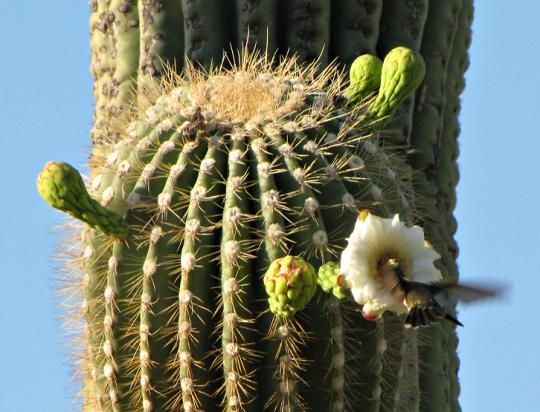|
|
Birds In The Cactus
|
In some species, both parents care for nestlings and fledglings; in others, such care is the responsibility of only one sex. In some species, other members of the same species—usually close relatives of the breeding pair, such as offspring from previous broods—will help with the raising of the young. Such alloparenting is particularly common among the Corvida, which includes such birds as the true crows, Australian Magpie and Fairy-wrens, but has been observed in species as different as the Rifleman and Red Kite. Among most groups of animals, male parental care is rare. In birds, however, it is quite common—more so than in any other vertebrate class. Though territory and nest site defence, incubation, and chick feeding are often shared tasks, there is sometimes a division of labour in which one mate undertakes all or most of a particular duty.
The point at which chicks fledge varies dramatically. The chicks of the Synthliboramphus murrelets, like the Ancient Murrelet, leave the nest the night after they hatch, following their parents out to sea, where they are raised away from terrestrial predators. Some other species, such as ducks, move their chicks away from the nest at an early age. In most species, chicks leave the nest just before, or soon after, they are able to fly. The amount of parental care after fledging varies; albatross chicks leave the nest on their own and receive no further help, while other species continue some supplementary feeding after fledging. Chicks may also follow their parents during their first migration.
• Brood parasites
Brood parasitism, in which an egg-layer leaves her eggs with another individual's brood, is more common among birds than any other type of organism. After a parasitic bird lays her eggs in another bird's nest, they are often accepted and raised by the host at the expense of the host's own brood. Brood parasites may be either obligate brood parasites, which must lay their eggs in the nests of other species because they are incapable of raising their own young, or non-obligate brood parasites, which sometimes lay eggs in the nests of conspecifics to increase their reproductive output even though they could have raised their own young. One hundred bird species, including honeyguides, icterids, estrildid finches and ducks, are obligate parasites, though the most famous are the cuckoos. Some brood parasites are adapted to hatch before their host's young, which allows them to destroy the host's eggs by pushing them out of the nest or to kill the host's chicks; this ensures that all food brought to the nest will be fed to the parasitic chicks.
|
|









